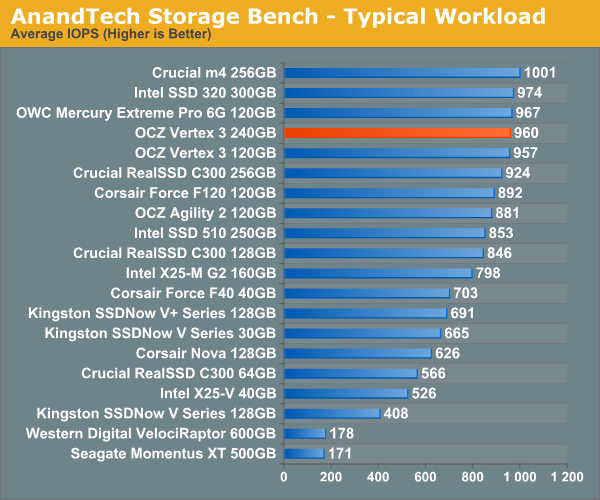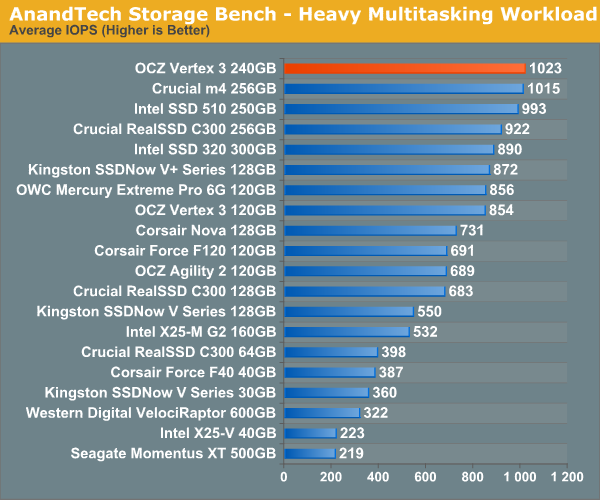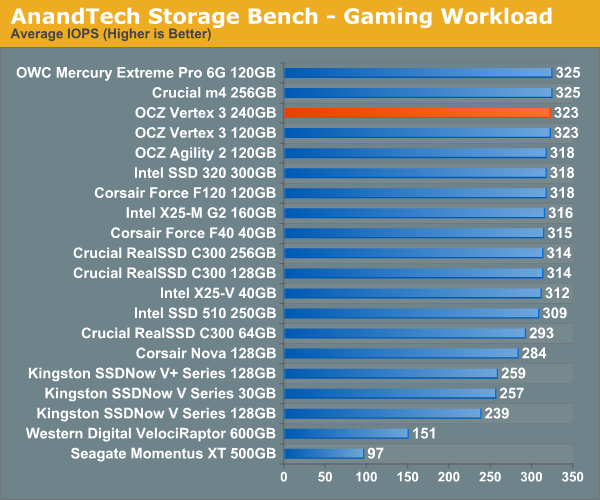OCZ Vertex 3 (240GB) Review
by Anand Lal Shimpi on May 6, 2011 1:50 AM ESTAnandTech Storage Bench 2010
To keep things consistent we've also included our older Storage Bench. Note that the old storage test system doesn't have a SATA 6Gbps controller, so we only have one result for the 6Gbps drives.
The first in our benchmark suite is a light/typical usage case. The Windows 7 system is loaded with Firefox, Office 2007 and Adobe Reader among other applications. With Firefox we browse web pages like Facebook, AnandTech, Digg and other sites. Outlook is also running and we use it to check emails, create and send a message with a PDF attachment. Adobe Reader is used to view some PDFs. Excel 2007 is used to create a spreadsheet, graphs and save the document. The same goes for Word 2007. We open and step through a presentation in PowerPoint 2007 received as an email attachment before saving it to the desktop. Finally we watch a bit of a Firefly episode in Windows Media Player 11.
There’s some level of multitasking going on here but it’s not unreasonable by any means. Generally the application tasks proceed linearly, with the exception of things like web browsing which may happen in between one of the other tasks.
The recording is played back on all of our drives here today. Remember that we’re isolating disk performance, all we’re doing is playing back every single disk access that happened in that ~5 minute period of usage. The light workload is composed of 37,501 reads and 20,268 writes. Over 30% of the IOs are 4KB, 11% are 16KB, 22% are 32KB and approximately 13% are 64KB in size. Less than 30% of the operations are absolutely sequential in nature. Average queue depth is 6.09 IOs.
The performance results are reported in average I/O Operations per Second (IOPS):

If there’s a light usage case there’s bound to be a heavy one. In this test we have Microsoft Security Essentials running in the background with real time virus scanning enabled. We also perform a quick scan in the middle of the test. Firefox, Outlook, Excel, Word and Powerpoint are all used the same as they were in the light test. We add Photoshop CS4 to the mix, opening a bunch of 12MP images, editing them, then saving them as highly compressed JPGs for web publishing. Windows 7’s picture viewer is used to view a bunch of pictures on the hard drive. We use 7-zip to create and extract .7z archives. Downloading is also prominently featured in our heavy test; we download large files from the Internet during portions of the benchmark, as well as use uTorrent to grab a couple of torrents. Some of the applications in use are installed during the benchmark, Windows updates are also installed. Towards the end of the test we launch World of Warcraft, play for a few minutes, then delete the folder. This test also takes into account all of the disk accesses that happen while the OS is booting.
The benchmark is 22 minutes long and it consists of 128,895 read operations and 72,411 write operations. Roughly 44% of all IOs were sequential. Approximately 30% of all accesses were 4KB in size, 12% were 16KB in size, 14% were 32KB and 20% were 64KB. Average queue depth was 3.59.

The gaming workload is made up of 75,206 read operations and only 4,592 write operations. Only 20% of the accesses are 4KB in size, nearly 40% are 64KB and 20% are 32KB. A whopping 69% of the IOs are sequential, meaning this is predominantly a sequential read benchmark. The average queue depth is 7.76 IOs.











90 Comments
View All Comments
Just3r1d7 - Saturday, May 7, 2011 - link
Dear Anand,I have been carefully reading SSD articles for the past 18 months waiting for the right time to make a purchase for both my home and work PCs... The depth and breadth of SSD coverage on AnandTech has been stellar, and this latest Vertex 3 review is no exception.
It's clear that the Vertex 3 240GB is the "best performing" drive for $500. However, as other posters have noted, all of the information floating around about SSDs hasn't necessarily resulted in clear guidelines or practical recommendations.
My guess is that the "average" user isn't going to spend $500 on an SSD for their home PC... Thus, as you continue to conduct these reviews, it may be helpful to compile a table/chart to guide your dedicated readers (and anyone else who browses the site). This would also have the benefit of reducing the number of "I have Processor A, Chipset B, and Operating System C, which SSD should I buy?" questions that arise.
Here are a few examples of questions which seem to come up repeatedly and could probably be answered by a summary table of recommendations based on drives currently available in retail channels:
1. What is the best "small" capacity drive? (at any cost)
2. What is the best "low cost" drive? (at any capacity)
3. What is the best performing OS/application drive?
4. What is the best drive for non-TRIM supported OS? (e.g. WinXP or Mac)
5. What is the best (most reliable) drive for a business PC?
Just some food for thought... Keep up the great work on the SSD coverage and reviews!
-Bob
Wardrop - Saturday, May 7, 2011 - link
Anyone know when OCZ will refresh their RevoDrive line with SF2xxx controllers? I'll be getting one of them.iwod - Sunday, May 8, 2011 - link
In an ideal world, the NAND would get smaller every node shrink, and we could fit more die inside an NAND package.However with every die shrink they also double the capacity of the minimum die size. i.e from 64Gbit to 128 Gbit ... etc
If 8 Channel and 8 NAND Package being a constant factor, we are only going to get more capacity at the same price, but not lower price at lower capacity.
Is there any reason behind this?
And that is why when i see people saying i will wait for SSD to drop below $50 etc.... They are halving the price every year so i will wait a year or two before i get it. The truth is it is never going to happen. The absolute minimum BOM *equation* for SSD has stay constant for years. Unless the minimum price per NAND die is going to drop, may be what we see today is already the absolute minimum price / SSD we will ever see?
ibliblibli - Sunday, May 8, 2011 - link
A thorough review, but I'd like to understand why the HDTach charts showing the read-and-write performance before-torture, after-torture and post-TRIM are not shown. I know the average sustained writes do not change much even after torturing the drive, but I'm interested in the volatility. None of other the articles covering the latest Sand Force drives (OCZ Vertex 3 Pro/Non-Pro 240 GB Previews, OCZ Vertex 3 120 GB Review, OWC Mercury Extreme Pro 6G Review) show this data either. However, the reviews for the other new drives (Intel 510, Intel 320 and Crucial m4) includes those charts. Is there a reason for this exclusion? The information from those charts is helpful.NorthShoreExile - Monday, May 9, 2011 - link
Based on the initial review, I ordered one for my new build. It took weeks to arrive but I finally got it. All I can say is "WOW"! It is everything it claims to be.jinino - Monday, May 9, 2011 - link
Great review Anand,From the photo in the last page, I see the disk is made in Taiwan. Do you happen to know that OCZ's SSD is manufactured by the same OEM in Taiwan as the manufacturer for Intel's SSD?
alpha754293 - Monday, May 9, 2011 - link
Wonderful review on the OCZ Vertex 3 SSD.I was wondering if you might be able to run the full h2benchw benchmark on the drive?
You should be able to download it here:
http://www.heise.de/software/download/h2benchw/378... or just google it.
Can you post or email me the results please?
Thank you.
ueharaf - Tuesday, May 10, 2011 - link
what is the difference between vertex 3 and solid 3?http://www.ocztechnology.com/ocz-solid-3-sata-iii-...
sanguy - Tuesday, May 10, 2011 - link
Hi,We just received 5 Vertex 3 240GB drives for installation into some Dell E6520 laptops. We did the install but with the Vertex 3 installed we've been having random system lock-ups that require a hard boot.
We are in AHCI mode in the bios and running Windows 7x64 with the 10.1 Intel RST drivers. Drives are firmware 2.02.
We are seeing this on several laptops/drives so it's not a one off.
Drive is detected by the toolkit OCZ has available, and RST reports it correct at 6Gbps.
These are sandy bridge quad core laptops using a 6 series chipset.
Anyone seeing compatibility issues? I did find a thread at OCZ over disabling some function in the registry which we did without it solving the issue.
DanaG - Wednesday, May 11, 2011 - link
I'd say Sandforce drives are just plain buggy, if you try to do anything non-desktop with them. (Even my old Indilinx drive was more stable.)From what you're seeing, the new ones must be even worse than the old ones.
Check my comments on Page 6, and this link:
http://www.ocztechnologyforum.com/forum/showthread...